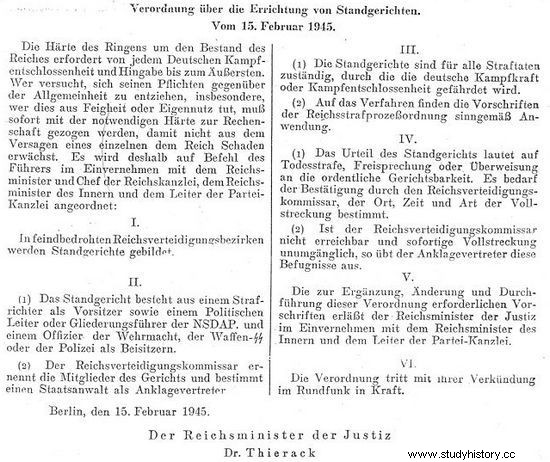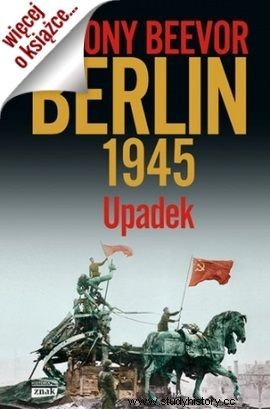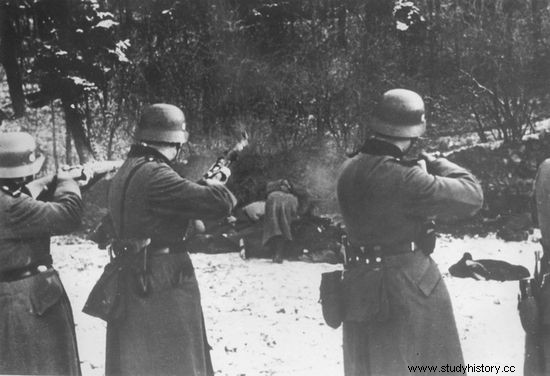It is no secret that the Germans ruled in the conquered countries with the use of bloody terror. However, in the Reich itself, the apparatus of repression was relatively less harsh and efforts were rather not to murder healthy "Aryan" citizens. Everything changed with the clearer end of Hitler's state.
The breakthrough in this regard came when the Red Army knocked on the gates of the "Thousand-year-old" Reich. The state apparatus began to crumble, and the population was increasingly louder that it was all the fault of the Führer. In this situation, the German Ministry of Justice - following the dictator's guidelines - decided to use proven methods which were used for years in occupied countries. I am talking about summary courts ( Standgerichte ), to operate in territories threatened by the enemy .
Bloody terror affects the Germans
They were brought into being by an ordinance issued on February 15, 1945 by the Reich Minister of Justice Otto Georg Thierack. It established that the guilt would be judged by a body headed by a professional judge. He was to be assisted by a higher officer of the NSDAP (or an organization affiliated with the party) and officers of the Wehrmacht, Waffen-SS or the police.
The appointment of the members of the judging team was done by the gauleiter (head) of a given district himself. Needless to say, the Gauleiters - the most fanatical of the Nazis - were eagerly awaiting the implementation of these laws ...

It was this regulation that made terror rage on an unprecedented scale in Germany.
As Ian Kershaw writes in the book “Führer. Fight to the last drop of blood ”, short-term judgments:
were to deal with any offenses that might weaken the fighting spirit , and issue one of the three verdicts:a death sentence, exonerating the defendant or referring the case to a court operating in the ordinary manner. The Reich Defense Commissioner approved the sentences and determined the place, time and method of execution.
In dispelling the possible doubts of the district governors, Martin Bormann - Hitler's trusted henchman - wrote:
Führer expects the Gauleiters to carry out their task with the necessary severity and consistency, and to ruthlessly stifle all signs of decay, cowardice and defeatism punishable by the summary court martial. Who is not ready to fight for the nation and stabs it in the back in the most difficult moment, does not deserve to live and must die at the hand of the executioner .
As you can see, summary courts did not really have much in common with the traditional understanding of the judiciary and the verdicts passed by them were actually only a formality. This is best evidenced by the statistics.

The preserved files show that they issued from six to seven thousand death sentences, which, of course, were eagerly carried out . It should be remembered that very often people did not even wait for such a quasi -A court decision and without any trial, the "traitors" of the Third Reich were murdered.
And what was this betrayal about? More than once, it was simply too loud to express doubts as to the effectiveness of the "miracle" weapon intended to ensure Germany's victory or to criticize the abuse committed by party officials.
Tens of thousands of victims
The omnipotence of summary courts became even greater after Hitler issued a decree establishing "flying summary courts" ( fliegendes Standgericht ) on March 9. ). Such "courts" messed around with what was left of the "Millennial" Reich and dealt with those accused of undermining the war effort in any way. The most frequently passed sentence was death.
It is no wonder, because - as Antony Beevor emphasizes in his book "Berlin 1945. The Fall" - it was clearly recommended that everyone the presiding judge was "deeply committed to the cause of our Reich" . Of course, there was no appeal against the verdict, and in order to "improve" the whole machine, the execution was carried out on the spot by the senior officer presiding over the "trials". There is nothing like the prosecutor, the judge and the executioner all in one .

Thanks to the regulation from February 1945, the inhabitants of the Third Reich felt the hard way what the Nazi regime of terror looked like in the occupied countries. The photo shows executions of civilians in Bochnia.
Unfortunately, due to the failure to adequately preserve the source material, it is difficult to say today how many court crimes have been committed by the "flying summary courts". However, one may be tempted to say that there were thousands or even tens of thousands of them.
Anyway, in the last phase of the war, German citizens had the opportunity to see for themselves what the "justice" of the brown regime looked like, which almost all of Europe experienced in the previous few years.
